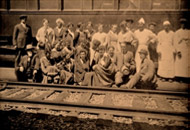“An early settlement in the Welch Neck….”
City Directories and History: (Information from: Names in South Carolina by C.H. Neuffer, Published by the S.C. Dept. of English, USC)
The Town of Kershaw, known in its earliest days as Welsh’s Station, derives its name from General Joseph Brevard Kershaw (1822-1894), a much admired South Carolinian in the post-Civil War years because of his reputation as leader of the famous Kershaw’s Brigade, CSA. General Kershaw was a native of Camden, a lawyer, and a man who lived up to his prominent lineage. His grandfather, Joseph, had come from England in 1748, settled at Camden, and acquired prominence and some fortune. He was active in the American cause during the Revolution. The General’s father, John, was several times Camden’s mayor, a state legislator, and a United States Congressman for one term.
Joseph Brevard Kershaw as a young man of twenty- one saw active duty in the Mexican War in 1843 as a lieutenant in the Palmetto Regiment. Returning to Camden because of illness, he took up the practice of law and in time became a leading citizen. He was elected to the legislature in 1852 and 1854 and was a member of the Secession Convention of 1860. In April, 1861, he was commissioned a colonel and took command of the Second South Carolina Volunteer Regiment, an organization which he had recruited. In 1862, when he was promoted to brigadier, his command became known as Kershaw’s Brigade and was made an element of Longstreet’s Corps, Army of Northern Virginia. Kershaw and his men engaged in some of the most vicious fighting of the war—at both battles of Manassas, at Antietam, Fredericksburg, and Chancellorsville. At Gettysburg the Brigade led the attack of Longstreet’s Corps and lost over half its personnel. Its most notable feat was accomplished at Chickamauga, when in a surging charge it crushed the right wing of the Federal Army and drove it from the field. Kershaw was promoted to Major General in May, 1864, and thereafter commanded a division through the declining days of the Confederacy. Captured at the end of the war, he was held a prisoner for several months at Fort Warren, Boston. On his release he returned to Camden, again took up the law, and was elected to the State Senate. In 1870 as a member of the Union Reform Party Convention he prepared the resolutions recognizing the Reconstruction acts. From 1877 to 1893 he was judge of the fifth circuit court, and in 1894, at the time of his death, he was Camden’s postmaster.
Behind the perpetuation of General Kershaw’s name in the present town is another Confederate soldier, only a private during his years of service, who was also at one time a Federal prisoner of war. This man was James V. Welsh (1845-1906), known in the post-war years to everyone by the courtesy title of “Captain.” He, too, came of a family that had figured in the history of the region. His great-great grandfather and great-great uncle, John and William Welsh, were prominent members of the pre-Revolutionary Regulators, those early rebels who rose against the Charleston authorities whom they accused of managing all the affairs of the Colony for the benefit of the Low Country. Their names exist in the State Archives as being pardoned after the Regulators had carried their point and wrung concessions from the government.
A second John Welsh, James V.’s great-grand-father, was a young soldier in the Revolution in the company of Captain John Blakeney, prominent citizen of the Cheraws and vestryman of Saint David’s Church. Captain Blakeney had raised a company, petitioned the Provisional Congress to accept its services, and had been commissioned in November, 1775. His company was subsequently a component of the brigade of General Francis Marion. Young John Welsh married his captain’s daughter, Jane Blakeney, and, taking an indent of pounds sterling issued him by the state for his services, expanded this into large land holdings in Chesterfield and Lancaster Districts. This indent is extant in the State Archives. There also exist records of John Welsh’s purchases of land, the largest single transaction among them one of 3,500 acres bought from General Thomas Sumter.
At the beginning of the Civil War James V. Welsh was sixteen years of age but before he was eighteen he was in the Confederate service. His father, John R. Welsh, and a brother, Thomas J., joined the Lancaster Invincibles, the father as a private. This organization became Company H of the Second Regiment of South Carolina Volunteers, Kershaw’s Brigade. Another brother, C. C., became a lieutenant in Company E, Twelfth South Carolina Infantry……a company commanded by their brother, Captain Francis Marion Welsh. Thomas was a sergeant in this outfit, but James never rose from the ranks of private. The military careers of the three brothers came to a simultaneous end in 1864 in eastern Tennessee, where, on detached duty to forage supplies for a hungry army, they were captured and shipped off to Federal prisons.
James made his way home on foot in the summer of 1865. During the Reconstruction years he worked at farming and store keeping and then turned to lumbering operations on the site which was to be Kershaw, a large sand bed covered with black oaks and pines in its pristine state. The former private, by this time “Captain,” convinced the Charleston, Cincinnati, and Chicago Railroad, which in 1877 was building a line from Camden to Marion, North Carolina, that a station in the vicinity of his saw mill would be profitable. To do this took some convincing, as the route was planned originally to pass several miles away, so the Captain offered tempting bait: he proposed to have a town laid out, to give the land needed for the streets, and to give every other lot in the business section to the railroad company. The railroad officials succumbed; a station was built, and the village of Welsh’s Station came into being. After some months Captain Welsh decided that he wished to honor a man he admired greatly, General Kershaw, whom he claimed as friend and in whom he saw what he considered many of the best qualities of the Southern character. He took the lead in the business of changing the name of the growing town, and Kershaw was incorporated in 1888. Some of the early citizens of this community bore the family names of Whitley, Carson, Wright, Horton, Folsom, Stevens, Blackmon, Croxton, Hilton, Heath, Clyburn, and Estridge.
George W. Malone, in a pamphlet of historical sketches of Lancaster County published at Lancaster in 1900, described Captain Welsh, then in his third term as mayor of Kershaw, as “a courteous and hospitable gentleman, cultured, refined, and pleasant… and possessed of sterling integrity.” Captain Welsh’s lumber mill, he wrote, planed 5,000 feet of lumber a day, and the Captain also had “fine productive farms, an excellent peach orchard, and a prolific vineyard.” James V. Welsh died in 1906, leaving his widow, the former Almetta Clyburn, whom he had married in 1871. His son, Grover C. Welsh, who was both state senator and sheriff of Kershaw County for several terms before his death in 1942, was the last of his……………………..
(Information from: Names in South Carolina by C.H. Neuffer, Published by the S.C. Dept. of English, USC)
Stay Connected
Explore history, houses, and stories across S.C. Your membership provides you with updates on regional topics, information on historic research, preservation, and monthly feature articles. But remember R&R wants to hear from you and assist in preserving your own family genealogy and memorabilia.
Visit the Southern Queries – Forum to receive assistance in answering questions, discuss genealogy, and enjoy exploring preservation topics with other members. Also listed are several history and genealogical researchers for hire.
User comments welcome — post at the bottom of this page.
Please enjoy this structure and all those listed in Roots and Recall. But remember each is private property. So view them from a distance or from a public area such as the sidewalk or public road.
Do you have information to share and preserve? Family, school, church, or other older photos and stories are welcome. Send them digitally through the “Share Your Story” link, so they too might be posted on Roots and Recall.
Thanks!
User comments always welcome - please post at the bottom of this page.


Share Your Comments & Feedback: